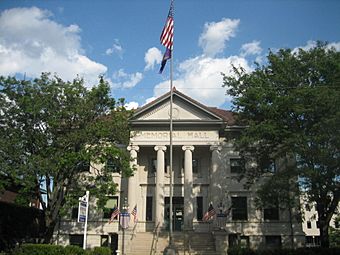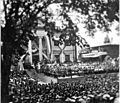Memorial Hall (Rockford, Illinois) facts for kids
Quick facts for kids |
|
|
Soldiers and Sailors Memorial Hall
|
|
 |
|
| Location | 211–215 N. Main St., Rockford, Illinois |
|---|---|
| Area | 0.4 acres (0.16 ha) |
| Built | 1903 |
| Architect | Bradley & Carpenter |
| Architectural style | Classical Revival |
| NRHP reference No. | 76000731 |
| Added to NRHP | January 31, 1976 |
Memorial Hall, also known as Soldiers and Sailors Memorial Hall or Veterans Memorial Hall, is a special building in Rockford, Illinois. It was built between 1901 and 1903. This hall was created to honor people who served in the Civil War and the Spanish–American War. Many believe it was the very first building of its kind in the United States.
The Hall is located on the west side of Rockford. It is just one block from the Rock River. Across the street, you'll find the Rockford Public Library. This building was first planned to honor Civil War veterans from Winnebago County, Illinois. However, before construction began, supporters added veterans from the Spanish-American War. Later, other veterans from Winnebago County were also honored there. This Memorial is unique because it's a building, not just a statue. The Winnebago County Board manages the building. President Theodore Roosevelt officially opened it on June 3, 1903.
Contents
What Does Memorial Hall Look Like?
Memorial Hall is a two-story building with a basement. The front (west side) and back (east side) of the Hall look almost the same. The front has the words 'Memorial Hall' and the year '1902' carved into it.
This building works as a museum. Inside, you'll find rooms with 18 special plaques. These plaques list the names of people from the area who fought for the Union in the American Civil War. They also list the names of those who died in the war.
The second floor has a large room called an auditorium with a stage. The basement has space for offices and storage. Offices for the Winnebago County Veterans Assistance Commission are in the basement. An elevator helps people get to all three floors.
Outside, on the east lawn, there is a large howitzer (a type of cannon). The Hall is also located on the Blue Star Highway. A tall flagpole stands at the front entrance. A smaller flagpole is located at the back of the building.
The inside of the Hall was once painted with many symbols and names. These were linked to the Grand Army of the Republic and the Civil War. In the main hall, along the top of the walls, you can see the names of over 20 battles. People from Winnebago County were involved in these battles.
How Memorial Hall Was Built
The Idea for a Memorial
The idea to honor veterans from Winnebago County started early. In 1866, a minister named W.P. Kinney suggested a monument. He wanted to remember the 2,109 soldiers and sailors from Winnebago County who served in the Civil War. In 1877, John D. Jackson asked the Winnebago County Board for $25,000. He wanted to build a soldier's monument.
In 1900, the people of Winnebago County voted on building a Memorial Hall. The vote was in favor, with 6,021 votes for and 2,757 against. In December of that year, Thomas G. Lawler led a group of over 200 veterans. They asked the county to build a Memorial Hall. They wanted it to be a memorial for veterans. They also wanted it to be used for other county purposes.
Building the Hall
The building was designed by Bradley & Carpenter. This was a local architecture company. Construction started in early 1901. The outside walls were built with Indiana Bedford limestone. This stone came from a quarry in Bedford, Indiana. Building Memorial Hall took 18 months. The total cost was $59,136.
President Roosevelt's Visit
In February 1903, the county invited President Theodore Roosevelt to dedicate the building. On June 3, President Roosevelt arrived in Rockford by train. Important citizens from Winnebago County met him. He and his group rode in open carriages to Memorial Hall.
President Roosevelt entered from the east side of the building. He took a moment to look at the inside of the building. Then he went outside to give his dedication speech. He told the crowd that "No more fitting memorial could be erected... than a hall such as this." After his speech, he raised a flag. This flag had flown on the USS Winnebago during the Civil War.
After the ceremony, President Roosevelt returned to his carriage. He took a longer way back to the train. This allowed him to wave to children lining the streets. He left Rockford just 51 minutes after he arrived. Roosevelt visited Rockford two more times. He came on April 6, 1912, and again on September 26, 1917. On his last visit, he spoke to troops at nearby Camp Grant during World War I.
How Memorial Hall Has Been Used
A Place for Veterans
On the same day President Roosevelt dedicated Memorial Hall, the Nevius Post #1 of the Grand Army of the Republic held its first meeting there. For over 100 years, Memorial Hall has hosted more than 60 different veteran groups. These groups use the Hall for events and meetings.
In the 1960s, the Hall was almost torn down. The County Board wanted to build a parking garage instead. But people fought to save it. In 1966, a large stone marker was placed at the front entrance. It honored the Hall's dedication. In 1973, a garden was dedicated to Vietnam War veterans.
The Hall's future became safer in 1974. It was named an Illinois Historical Landmark. In 1976, Memorial Hall was added to the National Register of Historic Places. This happened just in time for the United States Bicentennial.
In the 1980s, the County Board rented out offices on the first floor. This helped pay for the Hall's upkeep. A big restoration project began in 1988. It cost $1.5 million and lasted four years. This project fixed problems from a lack of maintenance.
Museum Exhibits
The Hall has many exhibits. You can see the 18 bronze plaques with names of Civil War soldiers. There are also items from the Revolutionary War up to the Iraq War. Some unique items on display include a World War I machine gun. There's also a plaque made from metal from the wreck of the USS Maine. You can also see items used by President Theodore Roosevelt.
The original paintings inside the Hall were very detailed. However, some have been covered or lost due to age and pollution. In 2001, the Memorial Hall Board of Trustees was created. They now manage the Hall, its upkeep, and its exhibits. In January 2005, Memorial Hall officially reopened for public tours. Many veteran groups and military groups now use the facilities.
100th Anniversary Celebration
In 2003, Memorial Hall celebrated its 100th Anniversary. An invitation was sent to President George W. Bush. He could not attend, but he sent a congratulatory letter. This letter was made into a plaque. It is now displayed next to the Roosevelt dedication remarks. The celebration included an actor who pretended to be Theodore Roosevelt. He even gave the same speech President Roosevelt gave at the original dedication!
Images for kids






